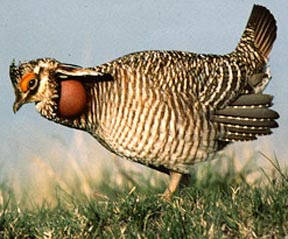The Lesser Prairie Chicken
 The U.S. Fish and Wildlife Service listed the Lesser Prairie Chicken (LPC) as a threatened species under the Endangered Species Act. It is estimated that in 2013 only 17,615 individuals existed and are confined to 17% of their historic rangeland. Some of the primary causes of the LPC decline are thought to be habitat loss and fragmentation, drought, fire suppression, industry development and rangeland conversion.
The U.S. Fish and Wildlife Service listed the Lesser Prairie Chicken (LPC) as a threatened species under the Endangered Species Act. It is estimated that in 2013 only 17,615 individuals existed and are confined to 17% of their historic rangeland. Some of the primary causes of the LPC decline are thought to be habitat loss and fragmentation, drought, fire suppression, industry development and rangeland conversion.
Background
The Lesser Prairie Chicken, or Tympanuchus pallidicinctus, is a North American grouse species. LPC are mostly brown with small white or tan horizontal stripes and are about the size of a domestic chicken. Males have red-purple air sacs on the side of their necks that inflate when courting females.
LPC are commonly known for their elaborate mating dance, which is performed in an open area called a lek. LPC are not very territorial, except for their leks, so home ranges of individuals overlap and vary by sex, age, season, and weather patterns.
Insects, such as grasshoppers, beetles, bugs, and caterpillars, are a key component of the LPC diet and are especially important for broods. LPC adults also eat vegetation, such as oaks, grain crops, sumac, and gromwell, depending on the season.
The primary causes of LPC population decline are habitat loss and fragmentation. Specifically, conversion of native prairie to cropland, long term fire suppression leading to tree invasion, grazing management practices, herbicide spraying, fragmentation caused by oil and gas development and wind energy development, fences and utility lines, prolonged drought and climate change.
LPC Life Cycle
The critical reproduction period ranges from March 1-July 15
- Breeding season is mid-March through May
- Nests are initiated mid-April though late May
- Hatching peaks in late May through mid-June
- Brooding occurs after hatching